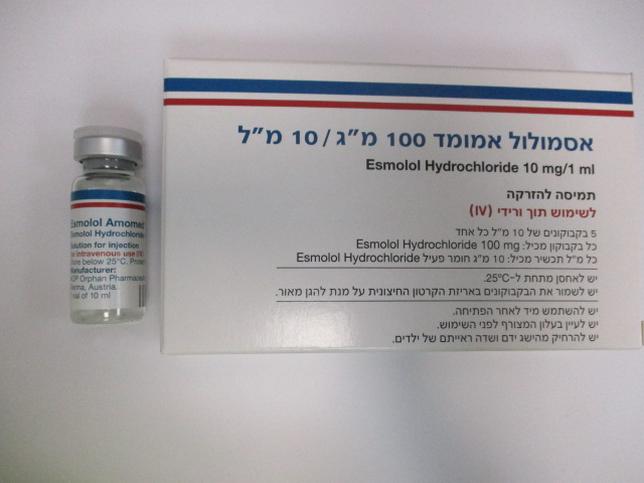Quest for the right Drug

אסמולול אמומד 100 מ"ג/ 10מ"ל ESMOLOL AMOMED 100 MG/10 ML (ESMOLOL HYDROCHLORIDE)
תרופה במרשם
תרופה בסל
נרקוטיקה
ציטוטוקסיקה
צורת מתן:
תוך-ורידי : I.V
צורת מינון:
תמיסה להזרקה : SOLUTION FOR INJECTION
עלון לרופא
מינוניםPosology התוויות
Indications תופעות לוואי
Adverse reactions התוויות נגד
Contraindications אינטראקציות
Interactions מינון יתר
Overdose הריון/הנקה
Pregnancy & Lactation אוכלוסיות מיוחדות
Special populations תכונות פרמקולוגיות
Pharmacological properties מידע רוקחי
Pharmaceutical particulars אזהרת שימוש
Special Warning עלון לרופא
Physicians Leaflet
Posology : מינונים
4.2 Posology and method of administration Esmolol Amomed 100 mg/10 ml solution for injection is a clear solution ready for intravenous use. The concentration of this product is 10 mg/ml Esmolol hydrochloride. SUPRAVENTRICULAR TACHYARRHYTHMIA The dosage of Esmolol should be titrated individually. A starting dose is required, followed by a maintenance dosage. The effective dose of Esmolol hydrochloride is within the range of 50 to 200 micrograms/kg/min, although doses as high as 300 micrograms/kg/min have been used. In a few patients the average effective dosage of 25 micrograms/ kg/min has been adequate. As the desired heart rate or safety endpoint (e.g. lowered blood pressure) is approached, OMIT the loading infusion and reduce the incremental dose in the maintenance infusion from 50 micrograms/kg/min to 25 micrograms/kg/min or lower. If necessary, the interval between the titration steps may beincreased from 5 to 10 minutes. NB: Maintenance doses above 200 micrograms/kg/min have not been shown to have significantly increased benefits, and the safety of doses above 300 micrograms/kg/min has not been studied. In the event of an adverse reaction, the dosage of Esmolol may be reduced or discontinued. Pharmacological adverse reactions should resolve within 30 minutes. If a local infusion site reaction develops, an alternative infusion site should be used and caution should be taken to prevent extravasation. The administration of Esmolol infusions for longer than 24 hours has not been thoroughly evaluated. Infusion durations greater than 24 hours should only be used with caution. Abrupt discontinuation of Esmolol in patients has not been reported to produce the withdrawal effects which may occur with abrupt withdrawal of beta-blockers following chronic use in coronary artery disease (CAD) patients. However, caution should still be used in discontinuing Esmolol infusions abruptly in CAD patients. PERIOPERATIVE TACHYCARDIA AND HYPERTENSION When treating tachycardia and/or hypertension in the perioperative setting, the following dose regimens may be used. a) For the intraoperative treatment – during anaesthesia when immediate control is required, a bolus injection of 80 mg is given over 15 to 30 seconds, followed by a 150 micrograms/kg/min infusion. Titrate the infusion rate as required up to 300 micrograms/kg/min. b) Upon awakening from anaesthesia administer an infusion of 500 micrograms/kg/min for up to 4 minutes followed by an infusion of 300 micrograms/kg/min. c) For postoperative situations when time for titration is available, give the 500 micrograms/kg/min loading dose over one minute before each titration step to produce a rapid onset of action. Use titration steps of 50, 100, 150, 200, 250 and 300 micrograms/kg/min given over four minutes, stopping at the desired therapeutic effect. Replacement of Esmolol therapy by alternative drugs Afternachieving an adequate control of the heart rate and a stable clinical status, transition to alternative drugs(antiarrhytmics or calcium antagonists) may be accomplished. When Esmolol is replaced by alternative drugs, the physician should carefully consider the labelling of the alternative drugand the dosage of Esmolol should be reduced as follows: 1) Within the first hour after the first dose of the alternative drug, the infusion rate of Esmolol should be reduced by one-half (50%). 2) After administration of the second dose of the other alternative drug, the patient response should be supervised and if satisfactory control is maintained for the first hour, discontinue the Esmolol infusion. Additional dosing information: as the desired therapeutic effect or a safety endpoint (e.g. lowered blood pressure) is approached, omit the loading dose and reduce the incremental infusion to 12.5–25 micrograms/kg/min. Also, if desired, increase the interval between titration steps from five to ten minutes. Esmolol Amomed 100 mg/10 ml solution for injection should be discontinued when heart rate or blood pressure rapidly approach or exceed a safety limit, and then restarted without a loading infusion at a lower dose after the heart rate or blood pressure has returned to an acceptable level. Elderly Special studies of elderly have not been performed yet. However, an analysis of data of 252 patients over 65 years indicated that no variations in pharmacodynamic effects occurred as compared with data of patients younger than 65 years. Patients with kidney insufficiency In patients with renal insufficiency caution is needed when Esmolol is administered by infusion, since the acid metabolite is excreted through the kidneys. Excretion of the acid metabolite is significantly decreased in patients with renal disease, with the elimination half-life increased to about tenfold that of normals, and plasma levels considerably elevated. Patients with liver insufficiency In case of liver insufficiency no special precautions are necessary since the esterases in the red blood cells have a main role in the Esmolol metabolism. Paediatric population (age under 18 years) There are limited data available on the use of Esmolol hydrochloride in children. The safety and effectiveness of Esmolol hydrochloride in children have not been established.

שימוש לפי פנקס קופ''ח כללית 1994
לא צוין
תאריך הכללה מקורי בסל
לא צוין
הגבלות
לא צוין
רישום
159 69 34872 00
מחיר
0 ₪
מידע נוסף
